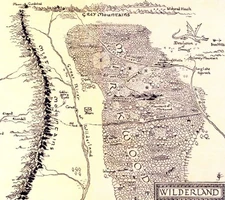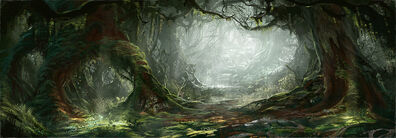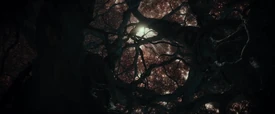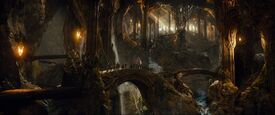Tag: Visual edit |
m (Added a second Swedish translation for mirkwood (mörkveden)) Tag: Visual edit |
||
| (17 intermediate revisions by 13 users not shown) | |||
| Line 3: | Line 3: | ||
|image=Hob_PRE_005.png |
|image=Hob_PRE_005.png |
||
|type=Forest |
|type=Forest |
||
| − | |location=[[ |
+ | |location=East of the [[Misty Mountains]], south of [[Ered Mithrin]] |
| − | |realms=[[Woodland Realm]]<br>[[Dol Guldur]] |
+ | |realms=[[Woodland Realm]]<br/>[[Dol Guldur]] |
|capital= |
|capital= |
||
|founded/built= |
|founded/built= |
||
| − | |ruler= |
+ | |ruler= |
| − | |summary= |
+ | |summary=Deep, thick, dark forest in Rhovanion |
| − | |names= |
+ | |names=Taur-nu-Fuin, Forest of Great Fear, [[Taur-e-Ndaedelos]], Greenwood the Great, Eryn Galen, Wood of Greenleaves, [[Eryn Lasgalen]] |
| − | |inhabitants=[[Wood-elves]]<br>[[Great Spiders]]<br> |
+ | |inhabitants=[[Wood-elves]]<br/>[[Great Spiders]]<br/>[[Nazgûl]]<br/>[[Orcs]]<br/>[[Woodmen]] |
| − | |languages=[[Sindarin]]<br>Silvan |
+ | |languages=[[Sindarin]]<br/>[[Silvan]]<br/>[[Black Speech]]<br/>[[Westron]]<br/>[[Orkish]] |
|lifespan= |
|lifespan= |
||
}} |
}} |
||
| Line 19: | Line 19: | ||
It was also known as '''Greenwood the Great''',''' Eryn Galen''' or '''Taur-e-Ndaedelos''', and was later re-named '''Eryn Lasgalen''',''' the Wood of Greenleaves'''. |
It was also known as '''Greenwood the Great''',''' Eryn Galen''' or '''Taur-e-Ndaedelos''', and was later re-named '''Eryn Lasgalen''',''' the Wood of Greenleaves'''. |
||
| − | ==Description== |
+ | == Description == |
[[File:Map_of_Mirkwood.jpg|thumb|left|225px|Map of Mirkwood in Wilderland, from ''[[The Hobbit]].'']] |
[[File:Map_of_Mirkwood.jpg|thumb|left|225px|Map of Mirkwood in Wilderland, from ''[[The Hobbit]].'']] |
||
| − | |||
| − | Fuck You |
||
Mirkwood was a dense and heavy woodland that made up much of the eastern portion of [[Rhovanion]] or the Wilderland, that maintained its borders and relative shape for many ages. Its natural land features included (in the northern part of the forest) the [[Mountains of Mirkwood]], a sizable river referred to in Tolkien's map as the [[Forest River]], that ran from the [[Grey Mountains]] down to [[Long Lake]], and a [[Enchanted river|smaller river]] that ran from the [[Mountains of Mirkwood]] to join with the Forest River west of the [[Elven-king]]'s [[Halls of Thranduil|Halls]].<ref>''[[The Atlas of Middle-earth]],'' The Third Age, "Introduction"</ref> This smaller river was enchanted (or polluted) to such an extent that it caused slumber and forgetfulness to anyone who fell into it.<ref>''[[The Hobbit]]''</ref> |
Mirkwood was a dense and heavy woodland that made up much of the eastern portion of [[Rhovanion]] or the Wilderland, that maintained its borders and relative shape for many ages. Its natural land features included (in the northern part of the forest) the [[Mountains of Mirkwood]], a sizable river referred to in Tolkien's map as the [[Forest River]], that ran from the [[Grey Mountains]] down to [[Long Lake]], and a [[Enchanted river|smaller river]] that ran from the [[Mountains of Mirkwood]] to join with the Forest River west of the [[Elven-king]]'s [[Halls of Thranduil|Halls]].<ref>''[[The Atlas of Middle-earth]],'' The Third Age, "Introduction"</ref> This smaller river was enchanted (or polluted) to such an extent that it caused slumber and forgetfulness to anyone who fell into it.<ref>''[[The Hobbit]]''</ref> |
||
| Line 29: | Line 27: | ||
Mirkwood's climate was relatively mild.<ref>''[[The Atlas of Middle-earth]],'' Thematic Maps, "Landforms"</ref> Except for ways through the thickets of the forest, there were very few commonly used routes through Mirkwood save the [[Old Forest Road]] and the [[Forest Path]]. Mirkwood was approximately 600 miles long from north to south and 250 miles across from west to east at its width. During the events of ''[[The Hobbit]]'' it was home to giant spiders, and the kingdom of King [[Thranduil]] and his [[Wood-elves|woodland elves]]<ref>''[[The Atlas of Middle-earth]],'' Regional Maps, "Eriador"</ref>; The Woodmen of Mirkwood also inhabited a small part of the forest. |
Mirkwood's climate was relatively mild.<ref>''[[The Atlas of Middle-earth]],'' Thematic Maps, "Landforms"</ref> Except for ways through the thickets of the forest, there were very few commonly used routes through Mirkwood save the [[Old Forest Road]] and the [[Forest Path]]. Mirkwood was approximately 600 miles long from north to south and 250 miles across from west to east at its width. During the events of ''[[The Hobbit]]'' it was home to giant spiders, and the kingdom of King [[Thranduil]] and his [[Wood-elves|woodland elves]]<ref>''[[The Atlas of Middle-earth]],'' Regional Maps, "Eriador"</ref>; The Woodmen of Mirkwood also inhabited a small part of the forest. |
||
| − | ==History== |
+ | == History == |
[[File:Mirkwood_01.jpg|396px|thumb]] |
[[File:Mirkwood_01.jpg|396px|thumb]] |
||
| Line 39: | Line 37: | ||
[[File:Mirk.png|thumb|275px|Light peering through the thick trees of Mirkwood]] |
[[File:Mirk.png|thumb|275px|Light peering through the thick trees of Mirkwood]] |
||
| − | ===Quest to Erebor=== |
+ | === Quest to Erebor === |
[[File:Desolation_-_Mirkwood.jpg|thumb|275px|Entrance to the Elvenking's Halls]] |
[[File:Desolation_-_Mirkwood.jpg|thumb|275px|Entrance to the Elvenking's Halls]] |
||
| − | [[Bilbo Baggins]], along with [[Thorin Oakenshield]] and his band of [[Dwarves]], ventured into Mirkwood during their quest to regain the [[Lonely Mountain]] from the [[dragon]] [[Smaug]]. There, the dwarf [[Bombur]] fell into the [[Enchanted river]]. Later, they came across many great [[Giant Spiders]] also known as the Spawn of Ungoliant. Shortly after the Dwarves' escape, they were captured by the elves. After or during these events the [[White Council]] attacked Dol Guldur, and Sauron fled to [[Mordor]], his influence in Mirkwood diminished for a while. Years later [[Gollum]], after his release from Mordor, was captured by [[Aragorn]] and brought as prisoner to Thranduil's halls. He escaped during an [[Orc]] raid, and fled south to [[Moria]]. |
+ | [[Bilbo Baggins]], along with [[Thorin Oakenshield]] and his band of [[Dwarves]], ventured into Mirkwood during their quest to regain the [[Lonely Mountain]] from the [[dragon]] [[Smaug]]. There, the dwarf [[Bombur]] fell into the [[Enchanted river]] (causing him to fall asleep). Later, they came across many great [[Giant Spiders]] also known as the Spawn of Ungoliant. Shortly after the Dwarves' escape, they were captured by the elves. After or during these events the [[White Council]] attacked Dol Guldur, and Sauron fled to [[Mordor]], his influence in Mirkwood diminished for a while. Years later [[Gollum]], after his release from Mordor, was captured by [[Aragorn]] and brought as prisoner to Thranduil's halls. He escaped during an [[Orc]] raid, and fled south to [[Moria]]. |
After Sauron was vanquished at the conclusion of the Third Age, the darkness was lifted from Mirkwood, and Thranduil gave it the name ''Eryn Lasgalen'' (Sindarin for ''wood of green leaves''), similar to its old name ''Eryn Galen'', or ''Greenwood''. |
After Sauron was vanquished at the conclusion of the Third Age, the darkness was lifted from Mirkwood, and Thranduil gave it the name ''Eryn Lasgalen'' (Sindarin for ''wood of green leaves''), similar to its old name ''Eryn Galen'', or ''Greenwood''. |
||
| − | ==Portrayal in adaptations== |
+ | == Portrayal in adaptations == |
| − | ===Peter Jackson's The Hobbit film trilogy=== |
+ | === Peter Jackson's The Hobbit film trilogy === |
Mirkwood is featured in Peter Jackson's ''[[The Hobbit: The Desolation of Smaug]]'' and ''[[The Hobbit: The Battle of the Five Armies|The Hobbit: The Battle of the Five Armies]]''. |
Mirkwood is featured in Peter Jackson's ''[[The Hobbit: The Desolation of Smaug]]'' and ''[[The Hobbit: The Battle of the Five Armies|The Hobbit: The Battle of the Five Armies]]''. |
||
| Line 60: | Line 58: | ||
}} |
}} |
||
| − | ===Video Games=== |
+ | === Video Games === |
Mirkwood is depicted in multiple video games, such as ''[[The Lord of the Rings: War of the Ring]]'', [[The Hobbit (2003 video game)]], [[The Lord of the Rings: The Battle for Middle-earth|''The Lord of the Rings: The Battle for Middle-earth'']], ''[[The Lord of the Rings: The Battle for Middle-earth II]]'', ''[[The Lord of the Rings Online]]'','' ''and [[War in the North|''The Lord of the Rings: War in the North'']]''.'' |
Mirkwood is depicted in multiple video games, such as ''[[The Lord of the Rings: War of the Ring]]'', [[The Hobbit (2003 video game)]], [[The Lord of the Rings: The Battle for Middle-earth|''The Lord of the Rings: The Battle for Middle-earth'']], ''[[The Lord of the Rings: The Battle for Middle-earth II]]'', ''[[The Lord of the Rings Online]]'','' ''and [[War in the North|''The Lord of the Rings: War in the North'']]''.'' |
||
| − | ==Notes== |
+ | == Notes == |
*Despite being called Mirkwood ever since [[TA 1050|Third Age 1050]], Mirkwood is referred to by [[Radagast]] and Gandalf in ''[[The Hobbit: An Unexpected Journey]]'' as the Greenwood, with Gandalf mentioning to the White Council that the woodsmen there only recently started calling it Mirkwood because of the sickness that had fallen over it. |
*Despite being called Mirkwood ever since [[TA 1050|Third Age 1050]], Mirkwood is referred to by [[Radagast]] and Gandalf in ''[[The Hobbit: An Unexpected Journey]]'' as the Greenwood, with Gandalf mentioning to the White Council that the woodsmen there only recently started calling it Mirkwood because of the sickness that had fallen over it. |
||
| Line 70: | Line 68: | ||
*In Middle-earth, Mirkwood refers to two forests, one which was later renamed [[Taur-nu-Fuin]] of [[Beleriand]], and the other west of the Lonely Mountain in [[Rhovanion]]. |
*In Middle-earth, Mirkwood refers to two forests, one which was later renamed [[Taur-nu-Fuin]] of [[Beleriand]], and the other west of the Lonely Mountain in [[Rhovanion]]. |
||
| + | |||
| − | ==Translations around the |
+ | == Translations around the world == |
| − | {| class="wikitable" style="text-align: center;" |
||
| + | |||
| ⚫ | |||
| + | <div style="overflow:auto; height:300px; width:500px; float:left"> |
||
| ⚫ | |||
| + | |||
| + | <!--<div style="overflow:auto; height:200px;">--> |
||
| + | {| class="itemtable" style="color:#6f3d0b; border:2px solid #FFF; border-top: 0; text-align:left; -moz-border-radius-bottomleft:8px; -moz-border-radius-bottomright:8px; -webkit-border-bottom-left-radius:8px; -webkit-border-bottom-right-radius:8px;" bgcolor="#edeeff" |
||
| ⚫ | |||
| ⚫ | |||
|- |
|- |
||
|Amharic |
|Amharic |
||
| Line 83: | Line 86: | ||
|Armenian |
|Armenian |
||
|Միրկւոոդ |
|Միրկւոոդ |
||
| ⚫ | |||
| + | |Basque |
||
| + | |Oihan Beltza (Mirkwood) |
||
| + | Oihan Berde Handiak (Greenwood the Great) |
||
|- |
|- |
||
|Belarusian Cyrillic |
|Belarusian Cyrillic |
||
| + | |Ліхалессе |
||
| − | |Міркўоод |
||
|- |
|- |
||
|Bengali |
|Bengali |
||
| Line 98: | Line 105: | ||
|- |
|- |
||
|Catalan |
|Catalan |
||
| − | |Bosc Llobregós |
+ | |Bosc Llobregós (Mirkwood) |
| + | Gran Bosc Verd (Greenwood the Great) |
||
|- |
|- |
||
|Chinese (Hong Kong) |
|Chinese (Hong Kong) |
||
|幽暗密林 (Mirkwood) |
|幽暗密林 (Mirkwood) |
||
| − | 巨綠森 (Greenwood the Great) |
+ | 巨綠森 (Greenwood the Great) |
|- |
|- |
||
|Czech |
|Czech |
||
|Temný hvozd (Mirkwood) |
|Temný hvozd (Mirkwood) |
||
| − | Velký zelený hvozd (Greenwood the Great) |
+ | Velký zelený hvozd (Greenwood the Great) |
|- |
|- |
||
|Danish |
|Danish |
||
| Line 116: | Line 124: | ||
|- |
|- |
||
|Estonian |
|Estonian |
||
| − | |Sünklaas |
+ | |Sünklaas (Mirkwood) |
| + | Suur Rohelaas (Greenwood the Great) |
||
|- |
|- |
||
|Finnish |
|Finnish |
||
| − | |Synkmetsä |
+ | |Synkmetsä (Mirkwood) |
| + | Suuri vihermetsä (Greenwood the Great) |
||
|- |
|- |
||
|French |
|French |
||
|Forêt Noire/Forêt de Grand'Peur (Mirkwood) |
|Forêt Noire/Forêt de Grand'Peur (Mirkwood) |
||
| − | Vertbois le Grand (Greenwood the Great) |
+ | Vertbois le Grand (Greenwood the Great) |
|- |
|- |
||
|Galician |
|Galician |
||
| Line 134: | Line 144: | ||
|- |
|- |
||
|Georgian |
|Georgian |
||
| − | |ბნელტევრი |
+ | |ბნელტევრი (Mirkwood) |
| + | დიდებული მწვანეტევრი (Greenwood the Great) |
||
|- |
|- |
||
|Greek |
|Greek |
||
| Line 143: | Line 154: | ||
|- |
|- |
||
|Hebrew |
|Hebrew |
||
| − | |מירקווד |
+ | |מירקווד/יעראופל |
|- |
|- |
||
|Hindi |
|Hindi |
||
| Line 162: | Line 173: | ||
|ಮಿರ್ಕ್ವುಡ್ |
|ಮಿರ್ಕ್ವುಡ್ |
||
|- |
|- |
||
| − | |Kazakh |
+ | |Kazakh |
| − | |Міркуоод |
+ | |Міркуоод (Cyrillic) Mirkwood (Latin) |
|- |
|- |
||
|Kyrgyz Cyrillic |
|Kyrgyz Cyrillic |
||
| Line 194: | Line 205: | ||
Wielkim Zielonym Lasem (Greenwood the Great) |
Wielkim Zielonym Lasem (Greenwood the Great) |
||
|- |
|- |
||
| − | |Portuguese |
+ | |Portuguese |
| − | |Floresta das Trevas |
+ | |Floresta das Trevas (Brazil) |
| ⚫ | |||
| ⚫ | |||
| − | |Portuguese (Portugal) |
||
| ⚫ | |||
|- |
|- |
||
|Romanian |
|Romanian |
||
| Line 222: | Line 231: | ||
|Swedish |
|Swedish |
||
|Mörkmården |
|Mörkmården |
||
| + | Mörkveden |
||
|- |
|- |
||
|Tamil |
|Tamil |
||
| Line 231: | Line 241: | ||
|- |
|- |
||
|Turkish |
|Turkish |
||
| − | |Kuyutorman |
+ | |Kuyutorman (Mirkwood) |
| + | Büyük Yeşil Orman (Greenwood the Great) |
||
|- |
|- |
||
|Ukrainian Cyrillic |
|Ukrainian Cyrillic |
||
| Line 246: | Line 257: | ||
|מירקוואָאָד |
|מירקוואָאָד |
||
|} |
|} |
||
| + | </div> |
||
| + | {{Clear}} |
||
| + | {{Realms of Men}} |
||
{{Elven Realms}} |
{{Elven Realms}} |
||
| − | ==References== |
+ | == References == |
<references /> |
<references /> |
||
Revision as of 22:43, 22 February 2020
Mirkwood was a great forest in Middle-earth located in the eastern region of Rhovanion between the Grey Mountains and Gondor.
It was also known as Greenwood the Great, Eryn Galen or Taur-e-Ndaedelos, and was later re-named Eryn Lasgalen, the Wood of Greenleaves.
Description

Map of Mirkwood in Wilderland, from The Hobbit.
Mirkwood was a dense and heavy woodland that made up much of the eastern portion of Rhovanion or the Wilderland, that maintained its borders and relative shape for many ages. Its natural land features included (in the northern part of the forest) the Mountains of Mirkwood, a sizable river referred to in Tolkien's map as the Forest River, that ran from the Grey Mountains down to Long Lake, and a smaller river that ran from the Mountains of Mirkwood to join with the Forest River west of the Elven-king's Halls.[1] This smaller river was enchanted (or polluted) to such an extent that it caused slumber and forgetfulness to anyone who fell into it.[2]
Mirkwood's climate was relatively mild.[3] Except for ways through the thickets of the forest, there were very few commonly used routes through Mirkwood save the Old Forest Road and the Forest Path. Mirkwood was approximately 600 miles long from north to south and 250 miles across from west to east at its width. During the events of The Hobbit it was home to giant spiders, and the kingdom of King Thranduil and his woodland elves[4]; The Woodmen of Mirkwood also inhabited a small part of the forest.
History

Mirkwood dates back to the earliest days of Middle-earth. The Elves passed through it on their Great Journey from Cuiviénen into the Far West - it was where they made their first long stop before continuing onward. Thereafter, Mirkwood was the dwelling of the Wood-elves (the Nandor, elves descending from the wandering Teleri elf Lenwë) for many thousands of years. The Sindarin Elf Oropher, one of the Grey-elves, who was the grandfather of Legolas, established the Woodland Realm proper, and it become the primary settlement of the elves from the Second Age onward. It was around this time that Men, possibly ancestors of the Northmen, began making permanent settlements in and around the forest. When Oropher was killed in the War of the Last Alliance, the kingship passed to his son Thranduil.
Mirkwood had been called Greenwood the Great until around the year TA 1050, when the shadow of the Dark Lord Sauron fell upon it, and men began to call it Mirkwood, or Taur-nu-Fuin and Taur-e-Ndaedelos in the Sindarin tongue. From then on, Mirkwood became a haunted place inhabited by many dark and savage things. Sauron established himself at the hill-fortress of Dol Guldur, an old Elven fortress that Oropher had control of, on Amon Lanc within its southern region, and drove Thranduil and his people ever northward, so that by the end of the Third Age they were a diminished and wary people, who had entrenched themselves within the Mountains of Mirkwood. The Old Forest Road (also called the Dwarf Road or Men-i-Maugrim) crossed the forest east to west, but because it was so close to Dol Guldur the road was mostly unusable. The elves then made a path farther to the north, which ended somewhere in the marshes south of the Long Lake of Lake-town.

Light peering through the thick trees of Mirkwood
Quest to Erebor

Entrance to the Elvenking's Halls
Bilbo Baggins, along with Thorin Oakenshield and his band of Dwarves, ventured into Mirkwood during their quest to regain the Lonely Mountain from the dragon Smaug. There, the dwarf Bombur fell into the Enchanted river (causing him to fall asleep). Later, they came across many great Giant Spiders also known as the Spawn of Ungoliant. Shortly after the Dwarves' escape, they were captured by the elves. After or during these events the White Council attacked Dol Guldur, and Sauron fled to Mordor, his influence in Mirkwood diminished for a while. Years later Gollum, after his release from Mordor, was captured by Aragorn and brought as prisoner to Thranduil's halls. He escaped during an Orc raid, and fled south to Moria.
After Sauron was vanquished at the conclusion of the Third Age, the darkness was lifted from Mirkwood, and Thranduil gave it the name Eryn Lasgalen (Sindarin for wood of green leaves), similar to its old name Eryn Galen, or Greenwood.
Portrayal in adaptations
Peter Jackson's The Hobbit film trilogy
Mirkwood is featured in Peter Jackson's The Hobbit: The Desolation of Smaug and The Hobbit: The Battle of the Five Armies.
 |
| File:Mirkwood Peek 01.png |
| File:Mirkwood Peek 02.png |
| File:Mirkwood Peek 04.png |
| File:Mirkwood Peek 03.png |
Video Games
Mirkwood is depicted in multiple video games, such as The Lord of the Rings: War of the Ring, The Hobbit (2003 video game), The Lord of the Rings: The Battle for Middle-earth, The Lord of the Rings: The Battle for Middle-earth II, The Lord of the Rings Online, and The Lord of the Rings: War in the North.
Notes
- Despite being called Mirkwood ever since Third Age 1050, Mirkwood is referred to by Radagast and Gandalf in The Hobbit: An Unexpected Journey as the Greenwood, with Gandalf mentioning to the White Council that the woodsmen there only recently started calling it Mirkwood because of the sickness that had fallen over it.
- Mirkwood also appears in The Fall of Arthur, as well as in one of Eriol's poems as Myrcwudu (Old English: 'Mirkwood'), which was an ancient Germanic legendary name for a great dark boundary-forest found in various different applications. Ælfwine's reference was to near the Eastern Alps, while the reference in the Fall of Arthur was somewhere east of the Rhine.
- In Middle-earth, Mirkwood refers to two forests, one which was later renamed Taur-nu-Fuin of Beleriand, and the other west of the Lonely Mountain in Rhovanion.
Translations around the world
| Foreign Language | Translated name |
| Amharic | ሚርክዎኦድ |
| Arabic | ميركوود |
| Armenian | Միրկւոոդ |
| Basque | Oihan Beltza (Mirkwood)
Oihan Berde Handiak (Greenwood the Great) |
| Belarusian Cyrillic | Ліхалессе |
| Bengali | মির্ক্wওওদ |
| Bosnian | Mrka Šuma |
| Bulgarian Cyrillic | Мраколес (Mirkwood)
Зеленогор Велики (Greenwood the Great) |
| Catalan | Bosc Llobregós (Mirkwood)
Gran Bosc Verd (Greenwood the Great) |
| Chinese (Hong Kong) | 幽暗密林 (Mirkwood)
巨綠森 (Greenwood the Great) |
| Czech | Temný hvozd (Mirkwood)
Velký zelený hvozd (Greenwood the Great) |
| Danish | Dunkelskov |
| Dutch | Demsterwold (Mirkwood)
Grote Groenewoud (Greenwood the Great) |
| Estonian | Sünklaas (Mirkwood)
Suur Rohelaas (Greenwood the Great) |
| Finnish | Synkmetsä (Mirkwood)
Suuri vihermetsä (Greenwood the Great) |
| French | Forêt Noire/Forêt de Grand'Peur (Mirkwood)
Vertbois le Grand (Greenwood the Great) |
| Galician | Bosque Escuro (Mirkwood)
Gran Bosque Verde (Greenwood the Great) |
| German | Düsterwald (Mirkwood)
Große Grünwald (Greenwood the Great) |
| Georgian | ბნელტევრი (Mirkwood)
დიდებული მწვანეტევრი (Greenwood the Great) |
| Greek | Μίρκγουντ |
| Gujarati | મિર્ક્વૉદ |
| Hebrew | מירקווד/יעראופל |
| Hindi | मिर्क्वोओद |
| Hungarian | Bakacsinerdő |
| Italian | Bosco Atro/Bosco tetro (Mirkwood)
Boscoverde il Grande (Greenwood the Great) |
| Japanese | 闇の森 (Mirkwood)
緑森大森林 (Greenwood the Great) |
| Kannada | ಮಿರ್ಕ್ವುಡ್ |
| Kazakh | Міркуоод (Cyrillic) Mirkwood (Latin) |
| Kyrgyz Cyrillic | Миркwоод |
| Macedonian Cyrillic | Миркwоод |
| Marathi | मिर्क्वोओद |
| Mongolian Cyrillic | Миркүоод |
| Nepalese | मिर्क्वोओद |
| Norwegian | Mørkeskogen/Myrkskog (Mirkwood)
Store Grønnskogen (Greenwood the Great) |
| Pashto | میرکووود ? |
| Persian | میرکوود |
| Polish | Mroczna Puszcza (Mirkwood)
Wielkim Zielonym Lasem (Greenwood the Great) |
| Portuguese | Floresta das Trevas (Brazil)
Floresta Tenebrosa (Portugal) |
| Romanian | Codrul Întunecat |
| Russian | Лихолесье (Mirkwood)
Великим Зеленолесьем (Greenwood the Great) |
| Sanskrit | मिर्क्वोओद् |
| Serbian | Мирквоод (Cyrillic) Divim Mrkoj (Latin) |
| Slovenian | Mrkolesje |
| Spanish (Spain and Latin America) | Bosque Negro (Mirkwood)
Gran Bosque Verde (Greenwood the Great) |
| Swedish | Mörkmården
Mörkveden |
| Tamil | மிர்க்௰ஓத் ? |
| Thai | เมิร์ควู้ด (Mirkwood)
ป่าใหญ่กรีนวู้ด (Greenwood the Great) |
| Turkish | Kuyutorman (Mirkwood)
Büyük Yeşil Orman (Greenwood the Great) |
| Ukrainian Cyrillic | Мірквуда (Mirkwood)
Ерін Ласгален (Eryn Lasgalen) |
| Urdu | مرکوود ? |
| Uzbek | Миркwоод (Cyrillic) Mirkwood (Latin) |
| Yiddish | מירקוואָאָד |
| Amon Ereb • Forest of Brethil • Dor-lómin • Eriador • Estolad • Ladros | |
| Arnor • Dunland • Gondor • Haradwaith • Númenor • Rhûn • Umbar | |
| Arnor (later split into Arthedain, Cardolan, and Rhudaur) • Rohan • Dale • Dunland • Lake-town (later part of the kingdom of Dale) • Gondor • Haradwaith • Khand • Rhovanion • Rhûn • Umbar • Vales of Anduin | |
| Dale • Haradwaith • Núrn • Reunited Kingdom of Gondor and Arnor • Rohan • Rhûn • Khand • Eriador • Vales of Anduin | |
References
- ↑ The Atlas of Middle-earth, The Third Age, "Introduction"
- ↑ The Hobbit
- ↑ The Atlas of Middle-earth, Thematic Maps, "Landforms"
- ↑ The Atlas of Middle-earth, Regional Maps, "Eriador"
